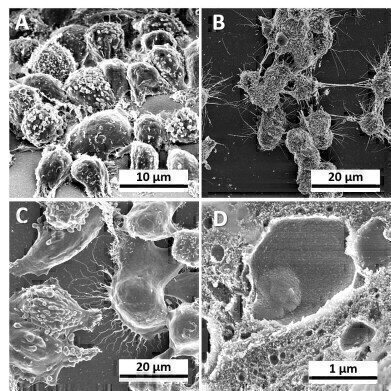-
 Cell on protein membrane, SEM. Credit: Bioprinting
Cell on protein membrane, SEM. Credit: Bioprinting
News & Views
3D Printed Membranes to suit any Lab
Aug 19 2021
For scientists studying how two different types of cell can influence each other, a simple model would be to isolate and separately culture two cell populations on a conditioned medium. One cell group would then be transferred onto the same growth medium of the second cell population to study interactions occurring. However problems can arise if the molecules of the introduced cell population are too short-lived to stabilise in the culture medium for long enough for transfer to the acceptor cell group. This would mean an absence of feedback signals existing in natural conditions.
Researchers of the Cell Signalling Regulation Laboratory at the Moscow Institute of Physics and Technology (MIPT) have developed a co-cultivation system that is said to be low-cost and reproducible compared to some of the existing systems. Based on a polymerized BSA membrane, its size and relief are determined by a mould created using a 3D printer. The possibility of co-cultivation is achieved with magnetic nanoparticles (NPs), cross-linked into the membrane, which allows it to be kept afloat in a culture liquid using a constant magnetic field.
Lead scientist Ilia Zubarev, senior research fellow at the MIPT Cell Signaling Regulation Laboratory, said: “We decided to create a matrix based on a cross-linked protein. Such systems are often used to simulate biological matrices. To achieve the possibility of co-cultivation of various cells, we chose an original solution that had not been used before. To maintain the protein membrane above a certain height inside the vessel, we decided to saturate it with magnetic nanoparticles. As the main component of the membrane, Bovine serum albumin (BSA) was chosen. This protein is non-toxic, widely available, is actively used in various fields of biology and as a rule, is already available in any laboratory.”
Cells cultivated on the membrane were found to have retained their viability and divisional capability, the membrane could be fixed for histochemical or immunocytochemical staining and the cells were able to be separated from the membrane for further study, the researchers said.
Zubarev added: “At the bottom of the Petri dish, as on the membrane, different types of cells were grown. The membrane with cells were kept afloat in the culture medium. For several days, the cells exchanged signals with each other and after that it was possible to assess their mutual influence.
Such a co-cultivation system can be manufactured in any laboratory, and it is a cost-effective alternative to commercial alteratives for cell co-cultivation."
The 3D printing method allows to flexibly and quickly adjust the manufacturing process to the needs of a particular laboratory. Such protein membranes can be made in any laboratory using a 3D printer and widely available general laboratory reagents.
The research was supported by the RNF grant 19-74-00081.
The study was published in the journal Bioprinting.
More information online
Digital Edition
Lab Asia 31.2 April 2024
April 2024
In This Edition Chromatography Articles - Approaches to troubleshooting an SPE method for the analysis of oligonucleotides (pt i) - High-precision liquid flow processes demand full fluidic c...
View all digital editions
Events
Apr 22 2024 Marrakech, Morroco
Making Pharmaceuticals Exhibition & Conference
Apr 23 2024 Coventry, UK
Apr 23 2024 Kintex, South Korea
Apr 23 2024 Seoul, South Korea
Apr 24 2024 Jakarta, Indonesia












.jpg)




